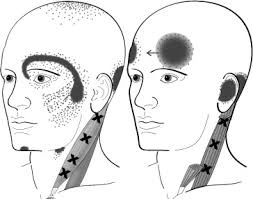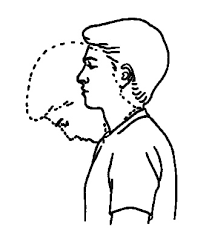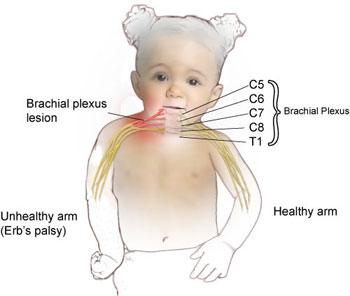Exercises For Occipital Neuralgia
Table of Contents
Exercises for Occipital Neuralgia
- Occipital Neuralgia, or ON, is an intense pain that wreaks havoc on life. It likely spawns from a pinched nerve in the back of the neck that can severely impact mobility, or make everyday activities more difficult.
- If an individual is experiencing Occipital Neuralgia, there is a solution to the pain. Simple exercises or small life changes that you implement can slowly strengthen the neck muscles or make you feel more like yourself again. Exercises for Occipital Neuralgia is a noninvasive approach that can help you manage the underlying pain or get you back to everyday life in no time.
- The Exercise will not only relieve the pain in the neck caused by Occipital Neuralgia, but it will also work to strengthen the neck muscles or improve the posture.
- Once the physical therapist diagnoses you or determines that the condition is Occipital Neuralgia, it’s time to move on to the exercises.
What is a Occipital Neuralgia?
- Definition of Occipital Neuralgia: Occipital neuralgia is a well-defined type of cervicogenic headache characterized by piercing, throbbing, or electric-shock-like chronic pain in the upper neck, back of the head, or back of the ears, generally on 1 side of the head. Typically, the pain of occipital neuralgia starts in the neck or then spreads upwards
- Occipital Neuralgia with unilateral pain that starts in the neck. Occipital neuralgia is a distinct type of headache symptom-wise by piercing, throbbing, or electric-shock-like chronic pain in the upper neck, back of the head, or back of the ears, usually on 1 side of the head. A common chronic or recurrent headache usually starts after neck motion. It is usually situated with a reduced range of motion (ROM) of the neck. Occipital Neuralgia was 1st introduced by Sjaastad et al.(1983).
- It is a chronic headache that begins from the atlantooccipital or the upper cervical joints or is perceived in 1 and more regions of the head or face. Some individuals will also feel pain in the scalp, forehead, or back of the eyes. Their scalp might also be tender to the touch, or their eyes especially sensitive to the light. The position of pain is related to the areas supplied by the greater or lesser occipital nerves, which travel from the area where the spinal column communicates with the neck, up to the scalp at the behind of the head.
- The pain occurs because of irritation and injury to the nerves, which might be the result of trauma to the back of the head, pinching of the nerves by more tight neck muscles, compression of the nerve as it leaves the spine due to osteoarthritis, and tumors or the other types of lesions in the neck. Localized inflammation and infection, gout, diabetes, blood vessel inflammation (vasculitis), or frequent lengthy periods of maintaining the head in a downward or forward position are also situated with occipital neuralgia. In many cases, however, no cause will be found. A positive response (relief from pain) after an anesthetic nerve block will work as a confirmation of the diagnosis.
Exercise Benefits In Occipital Neuralgia
- Utilizing physiotherapy exercises to treat Occipital Neuralgia arrives with many benefits. It is 1 of the most common forms of treatment for chronic neck pain. It will not just only relieve the pain in the neck caused by Occipital Neuralgia, but it might also work to strengthen the neck muscles or improve the posture.
Other benefits of physiotherapy treatment involve:
- Reduce pain or decrease stiffness
- Improve head or neck range of motion
- Develop dynamic strengthening of the neck or its supporting musculature
- Develop strategies to prevent pain from reoccurring
- It is only a method that does not involve any dangerous surgeries, medications, hospital visits and even needing to take time off from work. It is a natural method coached by a professional physiotherapist that, over time, will have you feeling more like being yourself.
- Once your physical therapist diagnoses you and determines that your condition is Occipital Neuralgia, it’s time to move on to the exercises. While the specifics may vary from person to person depending on the severity of your condition, these are a few overarching exercises that you can expect from your visits. However, you will want to make sure that you are always performing these with a doctor or physical therapist’s supervision. Failure to do so could result in serious injury.
Physiotherapy treatment of Occipital Neuralgia
- The doctor may give reference to you a physical therapist for treatment or also help to ease the neck pain.
You can try many things at home if the condition is mild
- Rest
- Take an over-the-counter(OTC)pain reliever, such as non-steroidal anti-inflammatory drugs (NSAID) or acetaminophen (Tylenol), which consists of ibuprofen or naproxen sodium.
- Use a hot pack and a cold pack on the neck for 7-10 mins which help to ease the pain.
- Exercise daily to help you recuperate faster.
- Wearing a cervical collar to limit motion or to provide a support
- In moderate conditions, you may prefer a physiotherapist.
Stretching Exercise for Occipital Neuralgia:
Splenius capitis muscle stretch
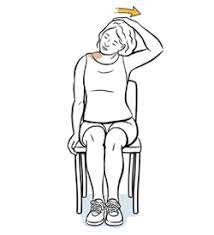
- The right-side splenius capitis is stretched by flexing, left laterally flexing, and left rotating the head and neck at the spinal joints, while the right-the-side shoulder girdle is allowed to elevate.
- You can hold for 30 seconds and 3 repetitions.
Splenius cervicis muscle stretch
- Stand or sit upright
- Keep your head up facing straight ahead
- Push your head forward side by sticking in your chin
- Note: Keep your head up during this stretch. Do not let your chin fall towards the floor.
- You can hold for 30 seconds and 3 repetitions.

Semispinalis capitis muscle stretch
- The semispinalis capitis muscle(of the transversospinalis group) is stretched by flexing the head and neck at the spinal joints. Adding in lateral
- flexion (not seen in the accompanying illustration) will increase the efficacy of the stretch for the opposite-side semispinalis capitis muscle.
- You can hold for 30 seconds and 3 repetitions.
Trapezius muscle stretch
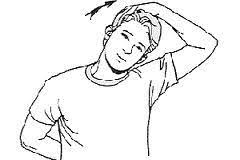
- Slowly take your left ear toward your left shoulder. It’s natural for your right shoulder to lift as you do this. If that happens, ease your head back toward the center until you can relax your right shoulder back down.
- Gently release this side, and then ease your right ear toward your right shoulder and complete the stretch on the other side, breathing deeply through it.
- You can hold for 30 seconds and 3 repetitions.
Splenius cervicis muscle stretch
- The left-side splenius cervicis muscle is stretched by flexing, right laterally flexing, and right rotating the neck at the spinal joints, while the left-side
- the shoulder girdle is allowed to elevate.
- You can hold for 30 seconds and 3 repetitions.
Suboccipital Muscle Stretch
Manual Stretching
Patient position and procedure: Sitting
- How to do:
- Identify the spinous process of the 2nd cervical vertebra and stabilize it with your thumb or with the second metacarpophalangeal joint (and the
- thumb and index finger around the transverse processes). Asked the patient slowly nodding, doing only a tipping motion of the head on the upper spine. Guide the movement by placing the other hand across the forehead of the patient. You can hold for 30 seconds and 3 repetitions.
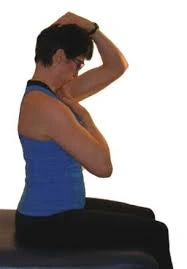
Patient position and procedure: Supine
- How to do:
- Sit on a stool at the head of the treatment table with the forearms resting on the table. One hand stabilizes the C2 vertebra by grasping the transverse processes between the proximal part of the thumb & index finger; the other hand supports the occiput. Nod the head of the patient with the hand under the occiput to take up the slack of the suboccipital muscles; then ask the patient to roll the eyes upward.
- This causes a gentle isometric contraction of the muscles of the suboccipital. After holding 6 secs, ask the patient to roll the eyes downward.
- As the suboccipital muscles relax, take up the slack by passively nodding the head through a new range. The only motion should occur between the occiput & C2.
- The contraction is gentle in order to not cause overflow into the multi-segmental erector spinal muscles & upper trapezius muscles.
- You can hold for 30 secs and 3 repetitions.
Self-Stretching
- How to do:
- Patient position and procedure: Supine or sitting. Instruct the patient to nod the head, bringing the chin toward the larynx until a stretch is felt in the suboccipital region. Putting light pressure under the occipital area with the palm of your hand while tipping the patient’s head forward reinforces the motion.
- You can hold for 30 seconds and 3 repetitions.
What should not you do during stretching?
- There are certain things the patient will not do during stretch:
- Do not stretch too much which causes injury or even damage to other body parts.
- Do not perform extra repetitions, this should be recommended times only.
- If the patient has prior pain or injury, he cannot perform stretching.
- When the patient feels discomfort or even pain during stretching, stop immediately.
- Do not perform so many stretches at a time that makes the muscles fatigue.
The isometric neck exercise
The isometric neck exercise that you can do while sitting, standing, or lying on your back:
Isometric neck exercise in standing position:
- For this exercise, you require a medium size ball or you have to stand nearer to the wall side.
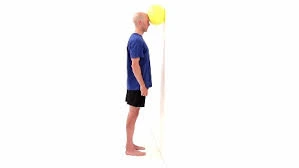
Neck flexion
- You have to stand straight with an erect posture, while the forehead is resting on a ball against the wall. By the forehead, you have to smoothly press the ball nearer to the wall.
- Maintain this position for 5 to 10 secs.
- The back should be straight or extended during the whole exercise.
Neck extension
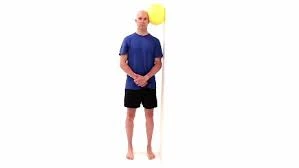
- You have to stand straight with an erect or upright posture, with the back of the head resting on a ball opposite the wall. By the head, you have to smoothly press the ball nearer to the wall.
- Maintain this position for 5 to 10 secs.
- The back should be in an upright position during the whole movement.
Neck Side flexion
- You have to stand straight with an erect or an upright posture, with the left side of the headrest on a ball opposite the wall.
- Slowly press the ball by the left side of the head nearer the wall.
- Maintain this position for 5 to 10 secs.
- The back should be in an upright position during the whole movement. Repeat this on another side also.
Isometric neck exercise in the Sitting position:
- In a sitting position for neck isometric exercise, you will need either a chair or a table. while you have to sit with an erect posture in a chair. In this position, you will do all neck motions which are explained under, or if you want to do this exercise in standing then you have to stand with the hip or the shoulder-width apart with the torso extended.
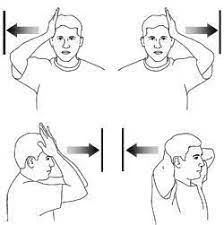
Neck flexion
- Put the hand on the forehead then slightly push the neck in a forward direction, the hand remains in the same position you give light pressure opposite the movements like pushing the beside.
- Hold this for 5 to 10 secs.
- The back should be in an upright position during the whole movement.
Neck extension
- Put the hand on the back of the head then gently push the neck in the backward direction, the hand should be in the same position, just give little pressure opposite the movements like pushing to the forward side.
- Hold this for 5 to 10 secs.
- The back should be in an upright position during the whole movement.
Neck Side flexion
- Put the hand left side of the head with the head straight or the chin in a neutral position, now bring the head towards the left side shoulder by gently pushing the hand by the head.
- Hold this for 5 to 10 secs.
- The back should be in an upright position during the whole movement.
- Repeat this for right-side neck flexion.
Neck Rotation
- Put the right hand on the left side of the chin or turn the head slightly nearer the left side by gently pushing the hand and trying to look back at you.
- The back should be in an upright position during the whole movement.
- Hold this for 5 to 10 secs.
- Perform this exercise on the right side by taking assistance from the left hand.
Isometric neck exercise in Supine lying position:
- For this exercise, you have to lie down on the back over a plinth or the mattress by using a small pillow or a rolled towel below the head, the hand by the side.
Neck flexion
- For this exercise you have to lie on the tummy pillow used under the head you have to push the pillow by the forehead or hold it for 5 to 10 secs.
Neck extension
- For this exercise, you have to lie down on the back over a plinth or a mattress by using a small pillow or a rolled towel below the head, the hand by the side.
- Push the pillow by the back of the head, or hold this for 5 to 10 secs.
Neck side flexion
- For this exercise, you have to lie on any side right or left side.
- Take a pillow below the head, now gently push the pillow by you nearer to the plinth.
- Hold this for 5 to 10 secs.
- Perform this on the right side.
When you should not do this exercise?
- If a person feels any pain or discomfort while performing an exercise.
- If you had any neck injury occur in a previous short period of time.
- If the doctor advised you for resting.
- If you had any head injury.
- If the symptoms worsen after doing a neck isometric exercise
- If you have high blood pressure, or you may have difficulty holding a breath.
Avoid these mistakes while performing isometric neck exercises:
- Do not move the shoulder or the trunk while doing an exercise.
- Do not give too much pressure on the head.
- Keep straight the neck while doing this exercise.
- Do not contract the muscle.
- Maintain the proper alignment of the neck while doing a neck isometric exercise.
Strengthening Exercises for Occipital Neuralgia
- Strengthening exercises for neck muscles including deep neck flexors or the upper quarter muscles
- Cervical spine mobilization techniques
- C1-C2 Self-sustained Natural Apophyseal Glide (SNAG) has shown to be effective for decreasing the Strengthening exercises for neck muscles consisting of deep neck flexors or the upper quarter muscles symptoms
- Thoracic spine thrust manipulation or exercise
- Upper cervical spine mobilizations
- Active mobilization exercises
- Work-related ergonomic training
- Passive mobilization with movement
- Thoracic Manipulation
- Deep Neck Flexor Exercise
- Active mobilization with movement
Trigger Point Therapy
- This is the combination of the different manual approaches, e.g., compression, stretching, and transverse friction massage. Pressure decreases over the sternocleidomastoid muscle. Pressure is given slowly and progressively to raise over the trigger point until the finger encountered a raise in tissue resistance (tissue barrier). This pressure is held until the therapist feels relief from the stressed band. At that time, the pressure is increased again until the next increase in tissue resistance. Stretching of the tight band muscle fibers is also necessary. Trigger point therapy is working for lengthening the trigger point in the muscle or the situated connective tissue. The physiotherapist gives moderate slow pressure over the trigger point or slides the fingers in alternate directions.
- This manual therapy is applied gently and calmly or is performed without inducing pain in the patients.
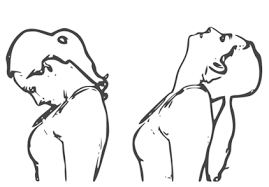
Co-contraction of the Neck Flexor or Neck Extensor
- It is facilitated with neck rotation or the neck exercises are illustrated once the patient can activate the deeper muscles.
- The patient will perform a self-resisted isometric rotation in the correct sitting position. They look into the palm or allow the resistance to facilitate the muscles or to perform the consecutive rhythmic to or fro stabilization exercises with an importance on the slow onset or slow-release maintaining contractions, by using resistance to match about a 10–20% effort. Retrain the strength of the superficial or the deeper flexor synergy.
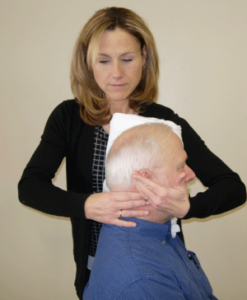
Extensors of the Craniocervical Spine
- The patient exercises the eccentric control of the head into the flexion occurring by the concentric control of the back to the neutral position in a four-point kneeling position to train the coordination of the deep or superficial cervical extensors. These exercises are done with re-education of the scapular muscles in these positions or begin in the program. The exercise is gradually been progressed by performing varying small ranges of craniocervical extension or flexion while holding the cervical spine in a normal position.

Tucked in Exercise
- The patient’s position should be Sitting straight & look straight ahead with the ears level parallel over the shoulders joints.
- Place 3 to 4 fingers on the chin.
- Maintain the finger, pull the chin & head extended beside up to a slow stretch is felt at the bottom of the base of the head & top of the neck.
- Maintain or hold for 5 to 10 secs. Repeat seven to ten times.

Neck flexion Exercise (Neck tilt)
- In Relax sitting position flex the head down to rest the chin on the chest (Flex the neck fully).
- Gently tense the neck muscles & hold for 4 to 8 secs.
- Return to the initial position & repeat seven to ten times.
Neck retraction exercises
- Sit on soft ground or a chair & then engage the core to help stabilize the spine.
- Brace the posterior muscles in the neck to bring the head back into a steady position while having the chin slightly downward.
- Maintain the position briefly.
- Relax & then repeat.
- Start with 1 set of 5 reps and work the way up to ten reps in total.
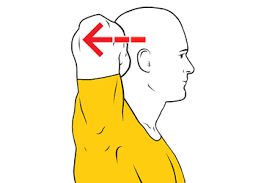
Isometric Neck extension exercise
- In Relax sitting position without arching the back, slowly move the head backward so you are looking upward.
- Hold for 5 to 10 secs. Return to starting position.
- This is a good exercise to do during working hours to prevent neck strain.
- Gently tense the neck muscles & hold for 5 to 10 secs.
- Return to a neutral position & repeat 10 times.
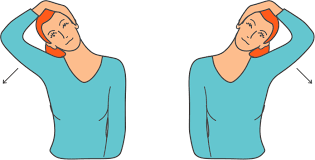
Neck flexion Exercise (side to side)
- Flex the head down towards the shoulder, & try to touch the shoulder with the ear (Without elevating the shoulder).
- Gently tense the neck muscles & hold for 8 secs.
- Return the head to a neutral position & repeat in the opposite direction.
- Repeat 10 times on both sides.

Isometric Neck Rotation exercise
- Begin this exercise by doing a rotation of the head towards 1 side, keeping the chin at the same level & moving within normal limits.
- Slowly stretch the neck muscles & hold for eight secs.
- Back the head to the neutral position & repeat in the other direction.
- Repeat 10 times on each side.
Re-education of the cervical flexors for anti-gravity function in a sitting position
- This re-education of the cervical flexors is a controlled eccentric action of the neck flexors onto the cervical extension range obeyed by a concentric action of these muscles to back the head to the normal erect position. The back to the correct position surely is initiated by CCF (craniocervical flexor), nor then a dominant action of the SCM (sternocleidomastoid).
- The exercise is gradually progressed by gently and slowly raising the range to which the head is moved into extension as control improves, or by introducing isometric holding through the range.
Prone Cobra Exercise
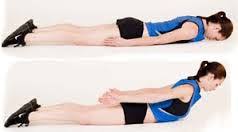
- This exercise is start by lying face downwards on the ground & assists gravity as resistance in the process.
- Put the face downwards on the floor, and put the forehead on a wrapped-up hand towel for support.
- Put the arms by the side, & palms downwards on the surface.
- Drag the tongue onto the upper palate of the mouth.
- Squeeze the shoulder blades combine & elevate the hands off the ground.
- Roll the elbows inside, palms outsides, & thumbs upside.
- Smoothly raise the forehead about an inch off the towel maintaining the eyes looking ahead forward at the ground
- Maintain the position for seven to ten secs.
- Do seven to ten reps.
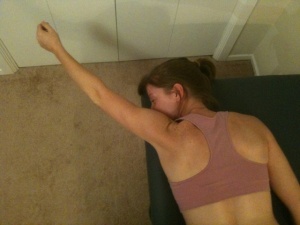
Retrain the Scapular Muscles
- Retrain scapular muscle which is oriented in posture betterment strategy is to have the patient movable the coracoid upward or the acromion backward, which ends in a slight retraction or the external rotation of the scapula. The aim is to facilitate the coordinated motion of all parts of the trapezius or the serratus anterior muscles, allowing the lower trapezius to little bit depress the medial portion of the scapula, consequently easing the levator scapulae.
- Once the patient habituates the correct scapular orientation, re-educate the endurance capacity of the scapular stabilizers again and again reps of 10-sec hold of the corrected scapular position to enhance the early endurance retraining. The endurance of the middle of the lower trapezius muscles is also educated by accomplishing an exercise in the prone lying position opposite the effects of gravity.
- Retrain scapular control is mannered with arm movement or load. This is necessary when activities such as computer work and desk work trigger pain. The patient is inspired by retaining their newly learned scapular position while doing small range (+/- 60 degrees) arm motions, for example, while working at a computer. Scapular control in coordination with control of cervicothoracic postural position is also trained for functional activities such as lifting or carrying objects.
Anterior stabilization lying head lift and rotation
- Lie flat on the back & then place the fingers slightly beneath the jaw till you feel the front neck muscles.
- Smoothly tuck in the chin or slightly lift the head about 1cm off the floor. Then slightly rotate the neck a few cm to each side slowly.
- Depending on the individual type of fitness, maintain the position for a minimum of 2 secs up to 5 secs per rep. Aim for 5 to 10 reps at a time in sets of 2 to 3.

Superman Exercise
- Do this exercise on a mat or a firm floor. Sleep down flat on the stomach while the arms are extended outside straight of the body.
- The legs should be maintained flat on the ground, as well as the arms.
- Lift the arms or the legs simultaneously like you are trying to fly. squeeze the lower back. Make sure to respiration occur properly.
- Depending on the individual type of fitness, maintain the position for a minimum of 2 secs up to 5 secs per rep. Aim for 5 to 10 reps at a time in sets of 2 to 3.
- Individual fitness levels will determine how many reps or sets the individual is capable of doing at a single time or in a single day.
Chin to chest Exercise
- Get into a sitting position on the ground. Put 2 hands at the base of the head with fingers interlocked.
- Staring the thumbs down or the elbows extended ahead.
- Do the head down to the chest or just hold it for 20 to 30 secs.
- Do ten reps of this exercise.

Head lifts
- You are Lie flat on the back with the arms stretched to the sides.
- Nod the head & tuck in the chin.
- Hold this exercise for a few seconds before releasing back to a neutral position.
- Hold this exercise position for 10 seconds.
- Perform the 10 times in 1 session & 3 sessions per day.
Upward Plank Exercise
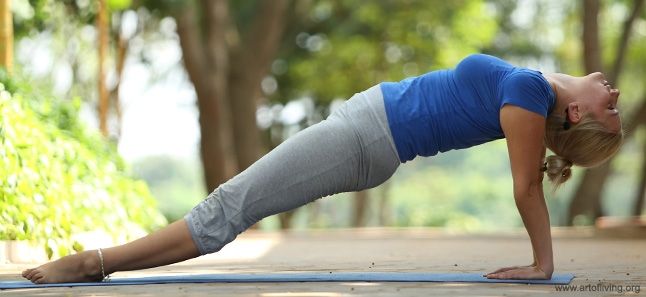
- This pose allows you to passively hang the head back & down, releasing tension in the neck & shoulders. This lengthens & stretches the longus capitis, SCM, chest, & shoulder muscles.
- Make sure the back of the neck is fully relaxed to avoid compressing the spine. If it is uncomfortable for you to let the head hang back, you can tuck the chin into the chest & lengthen the back of the neck. Precise on engaging the neck muscles without straining.
- You can also allow the head to rest back on some type of support such as a chair, a wall, or stacked blocks.
- How to do- Come into a seated position with the legs straight in front of you.
- Press the palms to the floor alongside the hips.
- Lift the hips & bring the feet under the knees.
- Deepen the pose by straightening the legs.
- Open the chest and & let the head drop back.
- Hold for up to 30 secs.
- Do this pose up to three times.
Upper Quarter Strengthening Exercises
- Middle Trapezius Strengthening
- Lower Trapezius Strengthening
- The addition of upper quarter exercises in the treatment plan for patients with cervical dysfunction is necessary to integrate ‘global’ muscles that have relations to the cervical spine through an anatomical chain.
Trapezius Strengthening exercise
- First, place the knee joint on a bench or chair.
- Try to lean forward so that the hand is reached the bench and also help to support the weight.
- The other hand is placed at the side and palm facing the body.
- Try to raise the arm and rotate the hand to the thumbs-up position.
- Stop this exercise when the hand is at shoulder height and the arm is parallel to the floor.
- Slowly lower the arm to the original position for a count of five.
- Do this exercise two to three times per day.
- Do the exercise by pressing on the side of the head. Repeat eight times, then on other sides.
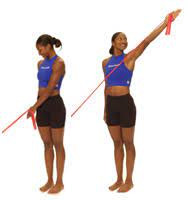
Trapezius Diagonals exercise
- The patient stands with theraband lower their opposite foot
- While grasping theraband, move shoulders up and down
- With your hand at your opposite hip, slowly raise it beyond
- your body, as if you’re pulling a blade
- Hold 3 seconds and repeat 10-15 times
Lateral Raises exercise
- Stand with the arm at your side with the elbow straight and the hands twisted so that the thumb’s face is ahead.
- put up the arm straight out to the side, palm downward, until the hands reach the shoulder position.
- Do not put up the hands forward than the shoulder. Pause and slowly down the arm.
- Perform 3 sets of 10-15 repetitions. for progression do this exercise with a dumbbell
Upright row exercise
- This is a common exercise for strengthening the trapezius. You can also try this exercise with dumbbells or a therabend in your hands.
- Stand up straight.
- With your fists held, pull up your fists as high as you can while bending your elbows, keeping your hands close to the front of your body. Hold for a count of ten.
- Release your arms back into a relaxed position, fists still hold
- Reprise 20 times.

Push-up exercise
- lying face down on the floor, positioning your hands slightly wider than your shoulders.
- Don’t lock out the elbows; keep them slightly bent.
- your legs should be straight back and balanced by your hands and toes. raise your body off the floor and back to starting position,
- 10-12 times.
Reeducate the Strength of the Superficial or the Deep Flexors Synergy
- The head raised must go 1st with CCF (craniocervical flexors) followed by cervical flexion to just raise the head from the bed. Gravity or the head weight gives resistance. Precautions must be taken that high load exercise is not taught too early, as it may be exaggerated the symptoms.
Re-education of Posture
- Posture is an attitude that is assumed by the body or an indirect measure of the functional position of the neuromuscular system
- The postural position is educated in a sitting position or is corrected from the pelvis.
- A different aspect of the training of postural position is the correction of the scapular position.
- The stability of a correct scapular position with significant muscle coordination has been the added benefit of creating reciprocal relaxation in the muscles.
Sensory-motor Training
- Because occipital neuralgia is believed to be a dysfunction of the sensorimotor system. Sensorimotor training consists of progressive exercise on unbalanced surfaces to promote reflexive stabilization or postural stability. Unbalanced surfaces such as exercise balls can be used to add more challenge to the cervical spine as well as the whole body for stability exercises. These end stages of the rehabilitation program for occipital neuralgia patients might be progressed toward functional activities to back the patient to fully participate.
Neck Strengthening with thera-band
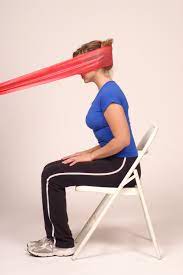
- These technics were basically posted isometric relaxation procedures (A) myofascial mobilization, or (B) selected elements of McKenzie therapy. Exercises were primarily given to the muscles with Trigger points, showing a pathological rising in the EMG amplitude. When relaxation is painful, tensed muscles are achieved, and the next step of treatment includes strengthening exercises of the neck muscles. All of the exercises are done under the supervision of a physiotherapist. Exercise intensity shall not raise the pain sensation in the cervical spine, and the shoulder girdle muscles. They aren’t responsible to provoke the headache.
- There are isometric exercises with a gently loading raising or dynamic exercises. Elastic thera bands are most generally used during these kinds of exercises. Additionally, the self-control exercises of the correction of the body posture are done out in front of the mirror relying on visual feedback.
Theraban Rows
- First Place the theraband around a doorknob & tie a knot in the theraband & close it in the door.
- The band is at head or chest level.
- You are sitting straight with each end of Theraband behind the head and the knee joint slightly bent, abdominal muscles tight.
- Must be Maintained the tight trunk muscles and then pull the head back while squeezing the shoulder blades together or combined.
- You are trying to focus on squeezing the shoulder blades without shrugging the shoulder joint up towards the ears.
- Then return to starting position but Do not lean back.
- Hold this exercise position for 10 seconds.
- Perform the 10 times in 1 session & 3 sessions per day.
Precautions While Doing Exercises
- Do not overdo the exercise.
- Wear light and proper clothes while doing exercise always.
- Keep your breathing normal.
- If you feel any discomfort while doing exercise, stop doing it and consult it your physiotherapist or doctor.
- Do not unnecessarily strain your neck muscles.
- Do not overstretch the muscles while doing neck exercises.
- Always begins neck exercise simply then and under the supervision of your physical therapist.
- Increase repetitions gradually.
Exercise To Avoid While Having Occipital Neuralgia
- It’s quite important to know that if at any time you are feeling an extra sharp pain in the neck, you should cease the exercises immediately. Over-exerting yourself when in recovery can be detrimental to your health or slow down the healing process.
- Avoid exercises that require added attention to the neck. This could include sit-ups or crunches, certain weightlifting routines like military press or lat pulldown, barbell shrugs, or bridges. If you ever have any questions or doubts about what you should or shouldn’t do, do not hesitate to contact the doctor.
Common Mistakes
Be sure to breathe deeper as well as evenly while doing the stretch. Focus on inhaling as you reach into the stretch or exhale to deepen the extension. Hold each stretch for a few secs of breaths then relax a hold. Activate a stretch again during resuming deeper breathing.
The simple act of deep breathing may increase the effects of a stretch significantly.
Additionally, not relaxing the face, neck, as well as shoulder muscles is also a common mistake when doing cow face poses. Assist decreased head and neck pain by actively relaxing the facial as well as neck muscles. Remember to embark at the top relax the forehead, cheeks, mouth, chin, neck, and finally, shoulders. This mental exercise will ensure that the patient is not tense during the whole stretch.
Safety and Precautions
If the patient experiences any pain, numbness, and even pinching during performing any of these stretches, stop and cut out of the stretch and exercise you are doing.
Make sure to breathe deeper as well as evenly while also relaxing the neck, face, and shoulder muscles.
FAQs
Is Occipital Neuralgia Serious?
Occipital Neuralgia is not a life-threatening condition, but it might have a major impact on the overall quality of the life. It might develop pain that interferes with daily activities of life or it may prevent you from enjoying time with family and friends.
What Triggers Occipital Neuralgia?
Occipital neuralgia most commonly occurs by the pinched nerves in the root of an individual’s neck. Sometimes this is caused by the neck muscles that are very tight in an individual’s neck. In a few cases, it can be caused by a head and neck injury. Long-term neck muscle tension is also a common cause.
What are the Signs of Occipital Neuralgia?
The primary symptom of trigeminal neuralgia is sudden attacks of severe, sharp, shooting facial pain that last from a few secs to about two mins. The pain is generally described as excruciating, like an electric shock. The attacks will be so severe that you are unable to do anything while they are happening.
What are the Treatments of Occipital Neuralgia?
Massage therapy.
Hot therapy, and using heating pads on the affected area.
Physical therapy.
Botulinum toxin (Botox) injections to reduce inflammation.
Nerve blocks, an injection of numbing medication, or steroids.Exercise Benefits in Occipital Neuralgia.
Utilizing physiotherapy exercises to treat Occipital Neuralgia arrives with many benefits. It is 1 of the most common forms of treatment for chronic neck pain. It will not just only relieve the pain in the neck caused by Occipital Neuralgia, but it might also work to strengthen the neck muscles or improve the posture.
Other benefits of physiotherapy treatment involve:
Reduce pain or decrease stiffness
Improve head or neck range of motion
Develop dynamic strengthening of the neck or its supporting musculature
Develop strategies to prevent pain from reoccurring

